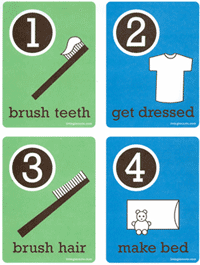Organize Your Homeschool
Are you trying to learn how to organize your homeschool? There are many myths circulating about homeschool organization.
Some people believe organizing your home school will reduce creativity and spontaneity in the home.
On the contrary, I believe home school organization that fits your personality, your natural habits and your family's lifestyle will:
- reduce stress,
- create a more peaceful, joyful atmosphere,
- allow you to accomplish more, and
- give you more time for fun.
Here's some information about establishing routines, homemaking, meal planning, time management and teaching multiple students that will help you organize your homeschool.
Establish Routines
Establish a daily routine that helps you accomplish the major objectives you need to accomplish each day.For instance, meal preparation, laundry and simple household cleaning must take place every day in order to keep a home running smoothly.
Having a homeschool schedule will allow you to accomplish these tasks quickly and easily, so you can relax and have fun without guilt. Here are some sample schedules, templates and tutorials that will help you create a homeschooling schedule that works.
Housework
The best way to organize your homeschool and stay on top of housework is to build habits that keep your house clean.
Have your children make their beds immediately after breakfast, and place their pajamas directly in the hamper after they get dressed. Start a load of laundry first thing in the morning, and load the dishwasher right after meals.
Cleaning in 15 minute spurts throughout the day is a great way to organize your homeschool. Set the timer and do a quick clean up before lunch, before dinner and before bed. In my home, we clean as a family so no one carries the load alone.
Here are some sample chore charts that I place on my children's doors and in their bathroom to remind them of their responsibilities.
These free printable routine cards from Living Locurto are perfect for helping little ones learn to work according to a routine:
Once you've established habits that keep your home neat, you can focus on deep cleaning.
For some, it works best to focus on one room per day. For example, laundry on Monday, bathrooms on Tuesday, the kitchen on Wednesday, and so on.
Others find that it works best to focus on one task per day. For example, dusting on Monday, floors on Tuesday, paperwork on Wednesday, and so on.
Limiting the amount of clothing and toys in children's bedrooms will make it easier for your children to keep their bedrooms tidy.
Having an organized homeschool room or area is essential part of homeschool organization. Follow this link to find creative ideas for organizing your home school room.
Meal Preparation
One of the toughest parts about home school organizing is that you have to prepare and clean up after meals 3 to 4 times per day!
Organize your homeschool, and reduce the time you spend on meal planning and preparation by:
- Preparing simple, nutritious breakfasts like eggs and toast, hot cereal, yogurt and fruit, or smoothies,
- Doubling your recipe for dinner, and serving leftovers for lunch,
- Setting aside one weekend per month to prepare make ahead meals, and
- Using your crockpot as frequently as possible.
One of our favorite books is Fix-It and Forget-It: 5-Ingredient Favorites.
This book is a treasure trove of easy crock pot recipes your family will enjoy. The recipes use simple ingredients that you can find in any grocery store, and each recipe contains five ingredients or less.
Several days per week, I put dinner in the crockpot while my kids are eating breakfast. I love ending a busy home school day knowing that I don't have to worry about what to prepare for dinner because it's already ready!
Follow this link to learn more about Fix-It And Forget-It.
Time Management
One of the most important steps you can take to organize your homeschool is to learn to properly manage your time. Here are 5 simple steps you can take to make the most of each moment of your day.
Set priorities. - Decide what tasks are most important to your family and do them first thing in the morning, before the day slips away. If you are having trouble finding time to teach your kids, establish school hours and plan appointments, errands and outings so you will be home during those hours.
Reduce or eliminate time wasters. - Don't answer the telephone or door during school hours. Return messages, check e-mail and peruse your favorite blogs after you've accomplished your objectives for the day.Get rid of any distractions that keep you from accomplishing those things that are most important to you.
Use your timer. - Set time limits for timewasters like telephone, electronic games, television and computers. Challenge yourself to complete certain tasks within a specified timeframe. You will be amazed at how much cooking, cleaning or schoolwork you can accomplish when you set time limits and focus on the task at hand.
Be realistic. - Don't overestimate what you can reasonably accomplish in a given day. I am really bad about setting unrealistic goals, so I often make to do lists, and reduce them by half or spread them out over a longer time period.
Delegate. - Let your kids help you with cooking and housework. Accept your friend's offer to bring dinner or come help you with errands. If your budget allows, hire a maid, tutor, landscaper, or mother's helper. You don't have to do everything on your own. It's okay to ask for help when you need it.
Remember to embrace your season of life. You can have it all, but you can't have it all at the same time. Sometimes we have to say no to co-ops and field trips in order to stay on top of housework, be home for naptime, or simply rest and refuel, and that's okay.
Teaching Multiple Students
If you have more than one child to teach, organize your homeschool by combining children in areas like Bible, history, science, art and geography. Study those subjects as a family, allowing each child to learn on his or her level.
Consider creating a checklist like the ones shown below in order to help your children learn to work independently:
Many homeschoolers have found success teaching multiple children by using Sue Patrick's workbox system.
Here is some additional information about workboxes that will help you organize your homeschool.
Homeschooling with Babies and Toddlers
Little ones truly are a blessing, but homeschooling with babies and toddlers can be quite a challenge.
You can hold babies in your lap or nurse them while you teach older children, or place them in a sling, swing, bouncy seat, jumper, play pen or high chair for short time periods.
Bring out special toys to entertain your toddler during school time. Pull out blocks on Monday, trains on Tuesday, duplos on Wednesday, and so on. Put on a favorite video or have one child entertain your toddler while you teach the other, then switch roles.
Let older toddlers and preschoolers sit with you and do school activities, if possible. Preschoolers can learn a great deal just by listening and observing.
Here's a video that will provide you with even more ideas for homeschooling with little ones.
It can be tempting to do school during your little one's naptime, but you also need to use some of that time to rest. My advice is to moms of babies and toddlers is to simplify as much as possible, save only the most important tasks for naptime, and remember, the baby is the lesson.
Claim Your Free Copy of
101 Ways to Save Money on Homeschooling!
Enter your name and e-mail address below to receive a FREE copy of 101 Ways to Save Money on Homeschooling!
You'll also join over 5,000 homeschoolers in receiving our free, monthly newsletter full of tips and ideas for Successful Homeschooling.
 |
Return from Organize Your Homeschool to How to Homeschool
Return from Homeschool Organization to Successful Homeschooling

